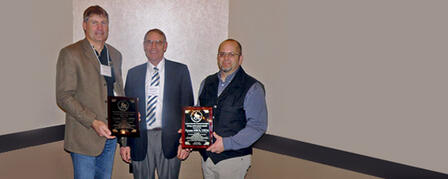KANSAS RECOGNIZED FOR USE OF NATIVE GRASSES IN CRP

Feb. 27, 2014
Group Achievement Award presented to Kansas federal agriculture agencies
WICHITA – The National Bobwhite Technical Committee (NBTC) recently bestowed their Group Achievement Award to the Natural Resources Conservation Service (NRCS) and Farm Service Agency (FSA) in Kansas. The award reflects achievements of groups of individuals or organizations that have had a measureable positive impact on wild bobwhite quail populations. The NBTC consists of the nation’s top bobwhite biologists, researchers, resource managers and conservation groups who are dedicated to restoring native bobwhite quail populations.
With this award, the NBTC is praising the Kansas offices of NRCS and FSA for their unique implemenation of the Conservation Reserve Program (CRP), which became part of the Farm Bill in 1985. CRP pays private landowners to take highly-erodible farmland out of production and plant it to grass. In the program’s early stages, Kansas policy makers were faced with critical decisions about the types of grasses that would be required in a state with such a wide diversity of soil types. Those policy makers determined the most beneficial cover for CRP would be mixes of warm-season, native grasses, the same grasses found in our native prairies. Looking back, it appears to have been one of those moments in time where all the stars aligned and policy was developed that would have major implications for the future of wildlife and other natural resources in Kansas.
The decision was not met with unanimous support. Other states wanted consistency across state lines and were pushing the use of Old World bluestems, which were cheap and relativity easy to establish. Native grasses were more expensive and practical experience in establishing those grasses was lacking. Many assumed the CRP program would not be around long enough to warrant the cost of expensive grass mixes only to see the land broken out again in the future. But staff in Kansas NRCS offices reasoned that establishing a mix of native grasses would provide the producer greater options for future use once the contracts expired. Kansas Department of Wildlife, Parks and Tourism staff knew the value of native grasses to wildlife and the department’s field biologists had been working with private landowners to establish native grasses through wildlife habitat enhancement programs. A seed company in western Kansas was already selling native plant materials and had experience developing mixes for various parts of the state.
With agreement among technical staff across agency lines in Kansas and private industry ready to meet the needs of producers, administrators within NRCS and FSA strongly backed the decision to use natives, ensuring long-term benefits for many Kansas wildlife species.
During the late 1990s, KDWPT began documenting the presence of the lesser prairie chicken in portions of their historic range where they had not been seen for more than 60 years. This significant re-occupation was due to nesting cover provided by native grasses in CRP. FSA and its partners in Kansas had been targeting CRP enrollment within the historic range of the lesser prairie chicken since 1996 by establishing Conservation Priority Areas. Since that time, increases in pheasant and quail populations have also been observed in those same areas. That portion of western Kansas is one of the only places in North America where quail populations have trended upward over the last couple of decades.
In making this award to NRCS and FSA, the NBTC also wanted to recognize individuals who were instrumental in making the “first native first” policy a reality nearly 30 years ago. Those individuals include James Habiger, former NRCS state conservationist, Jess Crockford, former NRCS state range conservationist, Bob Higgins and Rich Hager, former NRCS biologists, Al Schmatter, former FSA Conservation Program Manager, Bob Wood and Charles Lee, former KDWPT agriculture liaisons and Sharp Brothers Seed Company of Healy Kansas.
-30-









